|
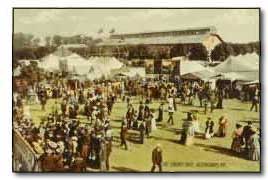 After operating for 36 years, the Great Allentown Fair had become too great for its own good. After operating for 36 years, the Great Allentown Fair had become too great for its own good.
The barns that housed the fairs prize dairy and beef cattle were bursting at the seams. Swine, sheep and poultry pens were crowded. The flowers and the bounty of the harvest competed more for space than for ribbons.
And most significantly to the continued success of the fair, the small grandstand and short race track could not accommodate the growing enthusiasm for harness racing.
Yes, the 36-year-old fair had outgrown its location. The grounds north of Liberty Street between 5th and 6th streets, which had been the site of the fair every year after the first exposition in 1852, could no longer handle the fairs attractions or attendance.
The members of the non-profit Lehigh County Agricultural Society which operated the fair knew they had to do something.
On April 4, 1889, they purchased 37 acres on 17th Street between Chew and Liberty streets. Although 14 acres were added later, the original purchase date is regarded as the birth of a landmark known to generations as the Allentown Fairgrounds.
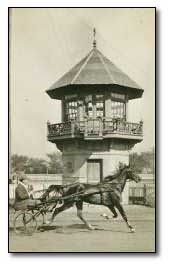 How could such a large tract of land amidst such a thriving area of Allentown have remained minimally developed for 100 years? Only the history of the society and its fair hold the answer. How could such a large tract of land amidst such a thriving area of Allentown have remained minimally developed for 100 years? Only the history of the society and its fair hold the answer.
Many agricultural societies started popping up throughout the pre-Civil War nation of the mid-19th Century. The men and women behind the country's number one industry sought recognition and, perhaps more importantly, recreation.
A History of the Lehigh County Agricultural Society published in 1902, the year after the semi-centennial of the Allentown Fair was celebrated, recounted the local society's emergence.
Its authors noted that "a number of leading farmers and enterprising citizens became interested in the project of forming an agricultural society, which was to have for its aim 'the improvement and advancement of agriculture, horticulture, livestock, and domestic and mechanic arts."
A series of meetings held during 1850 and 1851 finally culminated in definitive action on January 24, 1852. A large assembly gathered at the public house of William Leisenring in Egypt, Whitehall Township. There it was resolved to organize an agricultural society for Lehigh County and to fulfill its purpose by operating an annual fair.
Unlike many of today's events, the Allentown Fair was not planned over coffee in a corporate boardroom. Its forefathers traveled on horseback from the towns and townships of Allentown, Salisbury, Saucon, Upper Milford, Lower Macungie, Upper Macungie, Lynn, Lowhill, Heidelberg, Weisenberg, Washington, North Whitehall, South Whitehall, Hanover and Northampton.
After a constitution was adopted and officers were elected on February 3, 1852, plans for the first Lehigh County agricultural fair got underway. An eloquent description of those preparations was recorded in the 1902 history of the society.
Allentown, being at that time already a flourishing town and also the county seat, was selected as the most convenient place for this purpose. East of 4th Street, between Walnut and Union streets, lay a desirable five-acre plot of ground ... considered suitable for such an undertaking.
Booths and tents were put up to shelter and protect the displays, and here it was on October 6,7, and 8, 1852, that the first exhibition was held. The whole plot was enclosed by a white muslin screen seven feet high intended to prevent outsiders from viewing the show, and if it did not entirely serve that purpose, it must have revealed only enough to arouse double interest, for it is recorded that the fair was successful beyond the hopes of the most sanguine, and the receipts amounted to $1,200.
Such success was a mandate for subsequent fairs and a permanent location for them. An 8-acre tract north of Liberty Street between 5th and 6th streets was purchased in 1853. Additional purchases in later years brought the "Old Fairgrounds" up to approximately 14 acres enclosed by a wooden fence.
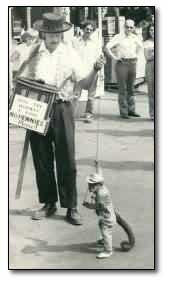 The largest buildings on the grounds were an exhibition hall known as the Main Building and a cottage-style ticket office. The largest buildings on the grounds were an exhibition hall known as the Main Building and a cottage-style ticket office.
The highlight of the old fairs, according to historians, was the final day public announcement to award the premiums to exhibitors. Hundreds gathered for this moment when the best from farm, orchard and household was recognized.
"FLYING COACH" WAS EARLY FAIR ENTERTAINMENT
Extravagant entertainment was limited to Stephen Lentz's Flying Coach, a horse-pulled flatbed with an improvised orchestra on it.
Apparently these attractions plus the sharing of the farming technologies of the day were adequate enticements for fair goers.
Eventually a one-third-mile race track and a small grandstand were constructed, adding to the lure of the fair. Harness racing was enormously popular and drew thousands of spectators.
It was this attraction, however, that put the ultimate squeeze on the grounds. Dissatisfaction with the exhibition buildings surfaced in the early 1880s, but by mid- decade the race track situation became a major concern.
In December 1888, three alternatives were presented to the society by a committee chosen to search for an expansion site. The first was a proposal to buy additional tracts adjoining the old fairgrounds, increasing its area to 22 acres. The second and third were possible new locations for the fair.
The site settled on was 37 acres owned by Solomon Gdesemer, S.D. Lehr and Catherine Newhart on 17th Street between Chew and Liberty Streets.
Although today this location is within the city's limits, 100 years ago it was in South Whitehall Township immediately west of Allentown. Fortunately the post office address was Allentown, because somehow "The Great South Whitehall Fair" does not have the same ring to it.
The old grounds were promptly sold on March 1, 1889 for $3,500 and the new grounds were purchased for $19,310 on April 4.
Work began immediately to ready the new grounds for the 1889 fair. The 1889 minutes of the Building Committee describe the transformation.
Many of the structures were transferred from the old grounds and re-erected on the new. These included Mechanics Hall, Floral Hall and the beer stand.
A frame structure was constructed next to the beer stand and it is believed it served as the original fairgrounds hotel. The minutes indicated that it was located on or near where the hotel-restaurant building stands today on the corner of 17th and Liberty Streets.
All of the horse, cattle, sheep and swine sheds were transferred from the old site, however, a row of 50 new box-stalls was added for the exclusive sheltering of speed horses.
A substantial new main exhibition hall went up along Chew Street offering 16,000 square feet of exhibiting spaces for needlework, fine arts and other displays.
A two-story frame cottage building with eastern and southern porches was built on the 17th and Chew Sts. corner. It served as quarters for the treasurer and his clerks, as well as a dwelling for the grounds' overseer. Turnstiles and gates for entrance and exit were located to the north and west of this building.
FAIRGROUNDS CHOSEN FOR NATURAL GROVE
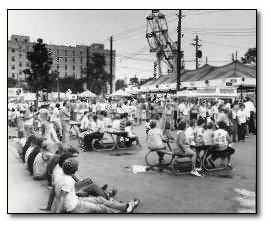 One of the features which attracted the society members to the new grounds was a natural grove to the east end along 17th Street. Fair officials decided to keep it free of concession stands for fair patrons' enjoyment. A fountain was transferred from the old grounds and served as a centerpiece to the circular benches that were constructed around the trees. One of the features which attracted the society members to the new grounds was a natural grove to the east end along 17th Street. Fair officials decided to keep it free of concession stands for fair patrons' enjoyment. A fountain was transferred from the old grounds and served as a centerpiece to the circular benches that were constructed around the trees.
Of course, the major new project was the new half-mile track and grandstand. In their description of this endeavor, the historians of 1902 revealed obvious pride.
The engineers and contractors "were instructed to build it in accordance with principles and contour recognized as the best by the ablest and most experienced turfmen. This resulted in the completion of a half-mile track of oval shape, 50 feet wide on the back stretch and 80 feet on the home stretch, with proper slopes at the turns."
The wooden grandstand erected sufficiently held 2,500 spectators and was equipped with a president s office, a restaurant and dining rooms.
With the finishing touch, a neatly painted six-and-one-half-foot fence enclosing the area in place, the new Allentown Fairgrounds was ready for its first fair.
Expectations were high for the fair which would inaugurate the new grounds. Local residents and tourists were primed for an exposition that would surpass all that preceded it.
"But alas!" it was exclaimed in the 1902 history. Mother Nature had other ideas. The four-lettered curse to outdoor events prevailed.
Rain slowed action on the grounds. But even more disappointing than the lower-than-expected attendance, the track's soggy condition prevented the harness racing trials.
To boost income and satisfy the public's anticipation for racing at the new track, the society decided to hold a special trotting meet three weeks after the fair.
The horsemen and spectators were duly impressed with the track, which distinguished it for future fairs. In fact, only five years after the maiden race, the grandstand had to be expanded for additional seating and lower level exhibition space.
GROUNDS ARE ENLARGED AS POPULARITY OF FAIR SKYROCKETS
The fair's growth during its first decade at the new grounds can be measured by its gross receipts, which actually tripled. For society members, however, the most gratifying success was an expanded fair with so many agricultural entries that the grounds again needed to be enlarged.
In 1897, 1 14-acre tract lying immediately on the western limits and bordering the developing Greenwood Cemetery was annexed to the grounds.
The turn of the century was a tremendous building period which produced some architecturally-striking structures. Older area residents may still recall many of them today.
The horse exhibition building made use of Victorian-styled windows and turrets for a unique appearance. Two large poultry houses erected along Chew Street had window-lined second levels to excellently light the exhibits. Floral Hall was an interesting hexagonal structure with a gingerbreading effect trimming its Pagoda-style roof.
A band stand of shell-shape design was added to the grove area. During the fairs of those times, it was reported in the 1902 history that "the famous Allentown band, assisted by eminent soloists from New York and Philadelphia, sent sweet strains through the grove and the grounds each day."
The most beautiful and memorable structure built at that time was the Agricultural Building, sometimes referred to as Horticultural Hall. It stood majestically along Chew Street on the grounds' central-southern section.
The Roman Cross-shaped Agricultural Building was characterized by a dome which produced a rotunda in the building's center. Older fair goers remember fruit and vegetables beautifully exhibited in the domed area.
After the successful semi centennial fair of 1901, a motion was made to build a new hotel and pavilion on the comer of 17th and Liberty streets.
Although it has been remodeled several times since, the "new' hotel is The Grille at the Fairgrounds restaurant and the pavilion is The Main Gate discotheque. Both are operated all-year-round today.
Between 1908 and 1913, new cattle sheds were built and annexes to existing buildings were added. The most dramatic building project of that era, however, was the construction of a new brick and concrete grandstand in 1911.
After only 12 years of use, the original wooden grandstand had been outgrown. The new edifice, a marvel for its time, could seat 7,070 spectators.
The grandstand has allowed the fair to keep pace with changing tastes in entertainment. It has seen it through harness racing, auto racing, glitzy Vaudeville productions and the world's most famous singers, musicians and comedians.
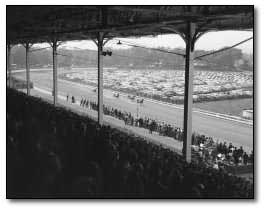 Up until the late 1920's, the nature of the fairgrounds was totally shaped by the needs of the fair. All of the buildings trees and shrubs, grassy areas and dirt avenues were installed to accommodate that one-week-a-year operation. Up until the late 1920's, the nature of the fairgrounds was totally shaped by the needs of the fair. All of the buildings trees and shrubs, grassy areas and dirt avenues were installed to accommodate that one-week-a-year operation.
The track's grass infield served as a baseball diamond for important area teams and the hotel on the northeast corner operated all-year-round. However, no major enterprise operated inside the fairgrounds' gates.
A longtime concessionaire changed all that in 1929 when he asked the society's permission to establish a permanent year-round eating place inside the grounds' perimeters. William R. "Billy" Ritz opened his Ritz Barbecue serving sandwiches and delicious 'made on the premises" ice cream.
The original frame structure Ritz leased eventually was expanded into a two- story brick building which afforded sit-down as well as window service. Parking was not too much of a problem during the business's infancy because not too many people owned cars. Most of Ritz's patrons boarded trolleys to the fairgrounds.
However, in the 1940s Ritz wanted to macadam the area in front of his restaurant. Society officials did not want to bear that expense, so Ritz himself spent $6000 to pave a parking lot.
And so it began, the grassy, park-like fairgrounds began to feel the pangs of progress. For the first time it was an operation other than the fair that changed the nature of the grounds. From that point forward all of the major building projects on the grounds have had more to do with activity other than fair week than fair week than with the annual exposition.
Current society Chairman Ed Charles explained this tendency. "We had to indulge in other incomes over the years to keep the fair going." He speculated, "if we had ever closed the fairgrounds' gates, the cost of real estate taxes, interest and expenses would have eaten up our fair."
All of the building and lease agreements were undertaken by a society mindful of its original purpose. Therefore, space which has gone over to commercial enterprises has not been space needed to operate the fair. Facilities leased during the year that are needed for fair week are vacated each year at that time. Even the stage, which was built in the 1920s to accommodate the Vaudeville productions of producer George Hamid, eventually was used for shows other than fair week.
NEW AG HALL OPENED IN 1957 CONSOLIDATING EXHIBITS
By the 1950s, all of the glorious old exhibit buildings along Chew Street were starting to look and act their age. Some were not even considered safe enough to take the continued strain put upon them by thousands of fair-goers.
Between accidental fires and planned demolition, all of them except the west- end poultry building were a memory by 1957. It was then that the new Agricultural Hall opened its doors onto 40,000-square feet of exhibition space all on one floor. This consolidated all of the agricultural, crafts, domestics and fine arts exhibits into one building during fair week.
While the fair attracts hundreds of thousands of visitors one week each year, Ag Hall, as it soon became knows, brings in thousands more for weekend auto, boat, home and other major trade shows year-round.
Before 1953, farmers had brought their produce to sell at the fairgrounds on weekends. They had used space under the grandstand and the other exhibition buildings.
That year, the organization of Devlin, Kistler and Wetzel leased the area under the grandstand to run a cooperative Farmers' Market.
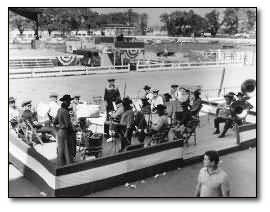 H & M Concessions took over the venture in 1958. This incorporation of brothers John and Thomas Hessinger and Roy Minninger paid one year's rent in advance to help the society build an annex to the grandstand building, more than doubling the indoor area. It serves as a replacement for the demolished main exhibit building and as extended space for the Farmers' Market. H & M Concessions took over the venture in 1958. This incorporation of brothers John and Thomas Hessinger and Roy Minninger paid one year's rent in advance to help the society build an annex to the grandstand building, more than doubling the indoor area. It serves as a replacement for the demolished main exhibit building and as extended space for the Farmers' Market.
The Farmers' Market and Ag Hall furthered the need for parking on the grounds.
The once gently sloped, grassy midway area was being worn to dirt. So while older fairgoers may reminisce about the once park-like fairgrounds, even an asphalt jungle has more appeal that did the dusty and sometimes muddy unpaved grounds worn by traffic.
The old barns for livestock were replaced by open-sided sheds that stretch along the western border of the grounds behind Ag Hall.
The old frame fair office and attached ticket office at the 17th and Chew streets comers also were demolished. New fair offices were build behind the Ritz Barbecue .and a new ticket office was located at the entrance to the paddock on the east end of the grandstand.
During this period a canopy was built over the stage to keep all fair shows a-go "rain or shine."
New turnstile were installed at the main fair entrance at 17th and Chew. The area which has been occupied by the old office building was [eased to the then - Lehigh Valley Trust Company and a bank built upon it in 1961.
The Youth Exhibit Building and horse stable near the Liberty and Lafayette streets entrance to the grounds burned down in the early 1960s. They were never replaced.
In 1976, the First National Bank of Allentown built a motor bank branch on the extreme northwest comer of the grounds which it leased.
In 1980, Michael "Skip" Germano leased the fairgrounds hotel and bier garten complex at 17th and Liberty streets. That year he restored the hotel to its original Victorian beauty and opened it as a restaurant.
BIER GARTEN BECOMES DISCO IN THE 80íS
Five years later the Germanos transformed the fair's bier garten into da discotheque. "The Main Gate," as they dubbed it, operates all-year-round.
For decades the society allowed free parking on the grounds for neighboring Allentown Hospital and other concerns. However, rising costs made it impossible for this to continue.
In 1980, a lease agreement was reached to have the eastern section of the grounds between the city's 17th Street and the fairgrounds' 4th Avenue serve as an Allentown Hospital parking lot. Part of this land, 1.4 acres, was purchased by the hospital in 1985 and is now the site of the Fairgrounds Surgical Center.
Another parking area along Chew Street was leased by the St. Cloud Associates of doctors' offices in 1983.
The last time the race track was used for harness and motor racing was in honor of the nation's bicentennial in 1976. It is unlikely racing will be resurrected again as the grandstand and stage have been fashioned into a show arena. In 1985, a fence enclosed the track where the audiences sit. New shower and dressing room facilities were built behind the stage in 1986.
With due attention paid to the buildings which have characterized the fairgrounds, it must be noted that, for the most part, the home of the Allentown Fair is an open expanse free from development.
The grounds have stayed in constant readiness for the "city within a city" which is erected annually at fair time.
The rural, country fair remains in spirit with the judging and exhibiting of livestock and agricultural products. Because that activity is confined to the west end of the grounds and a neon-lit midway sprawls where the exhibit buildings once were, many people who remember the earlier days feel that the fair has been taken over by a carnival and concession stands.
In actuality, the agricultural fair is thriving. More than 1,200 farm animals were entered in the 1998 exhibition filling every available shelter. Ag Hall showcased 7,000 entries from farm and home.
Still there is no argument that the fairgrounds' layout has been shaped by other- than-fair activities that have kept the society financially solvent. Ag Hall rentals comprise the largest of the society's "other-than-fair income followed by the rest of the tenants.
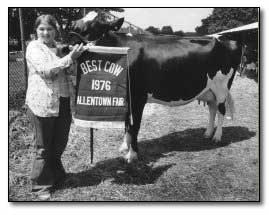 Today the Ritz Barbecue, resurrected from a fire that nearly destroyed it in 1998, ia a thriving business that nostalgia-lovers flock to. It is leased by Stinner Enterprises, Inc.. Germano still leases the hotel and bier garten complex, operated as "The Main Gate" discotheque and The Grille at the Fairground. Today the Ritz Barbecue, resurrected from a fire that nearly destroyed it in 1998, ia a thriving business that nostalgia-lovers flock to. It is leased by Stinner Enterprises, Inc.. Germano still leases the hotel and bier garten complex, operated as "The Main Gate" discotheque and The Grille at the Fairground.
Daniel Wuchter, a long-time market concessionaire, now runs today's Farmers' Market which has been extended to three days, Thursdays, Fridays and Saturdays.
First Union has taken over the motor bank on the northwest corner of the grounds and the 17th and Chew streets bank is now the Main Street Bank.
Other tenants rent parking areas of the grounds.
All of these tenants keep the fairgrounds bustling all-year-round. Yet everyone still looks forward to the granddaddy of all Lehigh Valley events.
|